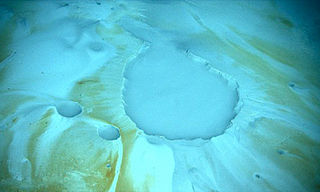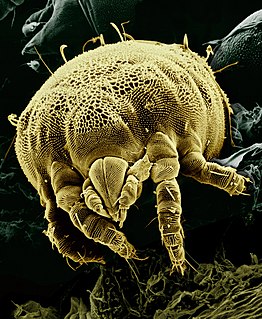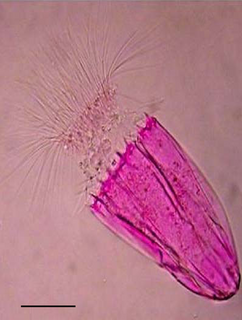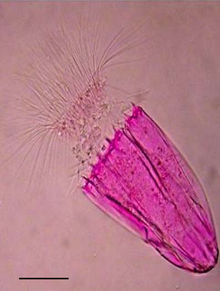
The Black Sea is a body of water, located in western Eurasia. Depending on the view, it is classified as a marginal sea, but also as the world's largest inland body of water. It is supplied by major rivers, principally the Danube, Dnieper and Don. The watersheds of many countries drain into the sea beyond the six that share its coast.

An extinction-level event is a widespread and rapid decrease in the biodiversity on Earth. Such an event is identified by a sharp change in the diversity and abundance of multicellular organisms. It occurs when the rate of extinction increases with respect to the rate of speciation. Estimates of the number of major mass extinctions in the last 540 million years range from as few as five to more than twenty. These differences stem from the threshold chosen for describing an extinction event as "major", and the data chosen to measure past diversity.

Loricifera is a phylum of very small to microscopic marine cycloneuralian sediment-dwelling animals with 37 described species, in nine genera. Aside from these described species, there are approximately 100 more that have been collected and not yet described. Their sizes range from 100 μm to ca. 1 mm. They are characterised by a protective outer case called a lorica and their habitat is in the spaces between marine gravel to which they attach themselves. The phylum was discovered in 1983 by Reinhardt Kristensen, in Roscoff, France. They are among the most recently discovered groups of Metazoans. They attach themselves quite firmly to the substrate, and hence remained undiscovered for so long. The first specimen was collected in the 1970s, and later described in 1983. They are found at all depths, in different sediment types, and in all latitudes.
An anaerobic organism or anaerobe is any organism that does not require oxygen for growth. It may react negatively or even die if free oxygen is present. In contrast, an aerobic organism (aerobe) is an organism that requires an oxygenated environment. Anaerobes may be unicellular or multicellular. Most fungi are obligate aerobes, requiring oxygen to survive, however some species, such as the Chytridiomycota that reside in the rumen of cattle, are obligate anaerobes; for these species, anaerobic respiration is used because oxygen will disrupt their metabolism or kill them.

The Ordovician–Silurian extinction events, also known as the Late Ordovician mass extinction (LOME), are collectively the second-largest of the five major extinction events in Earth's history in terms of percentage of genera that became extinct. Extinction was global during this period, eliminating 49–60% of marine genera and nearly 85% of marine species. Only the Permian-Triassic mass extinction exceeds the LOME in total biodiversity loss. The extinction event abruptly affected all major taxonomic groups and caused the disappearance of one third of all brachiopod and bryozoan families, as well as numerous groups of conodonts, trilobites, echinoderms, corals, bivalves, and graptolites. This extinction was the first of the "big five" Phanerozoic mass extinction events and was the first to significantly affect animal-based communities. However, the LOME did not produce major changes to ecosystem structures compared to other mass extinctions, nor did it lead to any particular morphological innovations. Diversity gradually recovered to pre-extinction levels over the first 5 million years of the Silurian period.
Reinhardt Møbjerg Kristensen is a Danish invertebrate biologist, noted for the discovery of three new phyla of microscopic animals: the Loricifera in 1983, the Cycliophora in 1995, and the Micrognathozoa in 2000. He is also considered one of the world's leading experts on tardigrades. His recent field of work revolves mostly around arctic biology.

Oceanic anoxic events or anoxic events (anoxia conditions) were intervals in the Earth's past where portions of oceans became depleted in oxygen (O2) over a large geographic areas. During some of these events, euxinia, waters that contain hydrogen sulfide, H
2S, developed. Although anoxic events have not happened for millions of years, the geological record shows that they happened many times in the past. Anoxic events coincided with several mass extinctions and may have contributed to them. These mass extinctions include some that geobiologists use as time markers in biostratigraphic dating. Many geologists believe oceanic anoxic events are strongly linked to slowing of ocean circulation, climatic warming, and elevated levels of greenhouse gases. Researchers have proposed enhanced volcanism (the release of CO2) as the "central external trigger for euxinia".

A hydrogenosome is a membrane-enclosed organelle of some anaerobic ciliates, trichomonads, fungi, and animals. The hydrogenosomes of trichomonads produce molecular hydrogen, acetate, carbon dioxide and ATP by the combined actions of pyruvate:ferredoxin oxido-reductase, hydrogenase, acetate:succinate CoA transferase and succinate thiokinase. Superoxide dismutase, malate dehydrogenase (decarboxylating), ferredoxin, adenylate kinase and NADH:ferredoxin oxido-reductase are also localized in the hydrogenosome. It is nearly universally accepted that hydrogenosomes evolved from mitochondria.

Scalidophora is a group of marine pseudocoelomate protostomes that was proposed on morphological grounds to unite three phyla: the Kinorhyncha, the Priapulida and the Loricifera. The three phyla have four characters in common — chitinous cuticle that is moulted, rings of scalids on the introvert, flosculi, and two rings of introvert retracts. However, the monophyly of the Scalidophora is not supported by molecular studies, where the position of the Loricifera was uncertain or as sister to the Panarthropoda. Both studies supported a reduced Scalidophora comprising the Kinorhyncha and Priapulida as sister phyla. Their closest relatives are the Panarthropoda, Nematoda and Nematomorpha; thus, they are placed in the group Ecdysozoa.
Anoxic waters are areas of sea water, fresh water, or groundwater that are depleted of dissolved oxygen and are a more severe condition of hypoxia. The US Geological Survey defines anoxic groundwater as those with dissolved oxygen concentration of less than 0.5 milligrams per litre. This condition is generally found in areas that have restricted water exchange.

A brine pool (sometimes called an underwater, deepwater lake, or "brine lake"') is a volume of brine collected in a seafloor depression. These pools are dense bodies of water that have a salinity three to eight times greater than the surrounding ocean. Brine pools are commonly found below polar sea ice and in the deep ocean. Brine pools below sea ice form through a process called brine rejection. For deep-sea brine pools, salt is necessary to increase the salinity gradient. This salt can come from one of two processes: the dissolution of large salt deposits through salt tectonics or geothermally heated brine issued from tectonic spreading centers. The brine often contains high concentrations of hydrogen sulfide and methane, which provide energy to chemosynthetic animals that live near the pool. These creatures are often extremophiles and symbionts. Deep-sea and polar brine pools are toxic to marine animals due to their high salinity and anoxic properties, which can ultimately lead to toxic shock and possibly death. The frequency of brine pool formation coupled with their uniquely high salinity has made them a candidate for research regarding ways to harness their properties to improve human science.

Micro-animals are animals so small that they can be visually observed only under a microscope. Unlike most other microorganisms, that are unicellular, micro-animals are unique because they are multicellular, like all other animals.

L'Atalante basin is a hypersaline brine lake at the bottom of the Mediterranean Sea about 192 km (119 mi) west of the island of Crete. It is named for the French L'Atalante, one of the oceanographic research vessels involved in its discovery in 1993. L'Atalante and its neighbors the Urania and Discovery deep hyper saline anoxic basins (DHABs) are at most 35,000 years old. They were formed by Messinian evaporite salt deposits dissolving out of the Mediterranean Ridge and collecting in abyssal depressions about 3,000 m (9,800 ft) deep. L'Atalante is the smallest of the three; its surface begins at about 3,500 m (11,500 ft) below sea level.

Spinoloricus cinziae is an animal species described in 2014 in the phylum Loricifera.
The Cenomanian-Turonian boundary event, or the Cenomanian-Turonian extinction event, the Cenomanian-Turonian anoxic event, and referred also as the Bonarelli event, was one of two anoxic extinction events in the Cretaceous period. Selby et al. in 2009 concluded the OAE 2 occurred approximately 91.5 ± 8.6 Ma, though estimates published by Leckie et al. (2002) are given as 93–94 Ma. The Cenomanian-Turonian boundary has been refined in 2012 to 93.9 ± 0.15 Ma There was a large carbon disturbance during this time period. However, apart from the carbon cycle disturbance, there were also large disturbances in the oxygen and sulfur cycles of the ocean.
Australoricus oculatus is a species of Loricifera, a species of microscopic marine sediment-dwelling animals, in the family Nanaloricidae. It is the only described species in the genus Australoricus. It was discovered in sea caves off New South Wales in Australia.

Titaniloricus is a genus of small marine animal in the phylum Loricifera. It contains a single species, Titaniloricus inexpectatovus, described by Gunnar Gad in 2005. It has been collected from the abyssal plain in Angolan waters of the Atlantic Ocean.
Phoeniciloricus is a monospecific genus of loriciferans, a phylum of small marine sediment-dwelling animals. Its one species is Phoeniciloricus simplidigitatus.
Euxinia or euxinic conditions occur when water is both anoxic and sulfidic. This means that there is no oxygen (O2) and a raised level of free hydrogen sulfide (H2S). Euxinic bodies of water are frequently strongly stratified, have an oxic, highly productive, thin surface layer, and have anoxic, sulfidic bottom water. The word euxinia is derived from the Greek name for the Black Sea (Εὔξεινος Πόντος (Euxeinos Pontos)) which translates to "hospitable sea". Euxinic deep water is a key component of the Canfield ocean, a model of oceans during the Proterozoic period (known as the Boring Billion) proposed by Donald Canfield, an American geologist, in 1998. There is still debate within the scientific community on both the duration and frequency of euxinic conditions in the ancient oceans. Euxinia is relatively rare in modern bodies of water, but does still happen in places like the Black Sea and certain fjords.
Parablepharismea is a class of free-living marine and brackish anaerobic ciliates that form a major clade of obligate anaerobes within the SAL group, together with the classes Muranotrichea and Armophorea.











